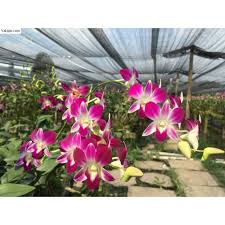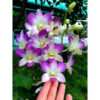# The Evolution of Dendrobium Orchids Through Historical Periods

Dendrobium orchids, belonging to one of the largest genera of the Orchidaceae family, have captured the fascination of botanists, horticulturists, and flower enthusiasts for centuries. With over 1,800 species, Dendrobium orchids are not only admired for their beauty and diversity but also for their historical significance and cultural relevance. This article explores the evolution of Dendrobium orchids through various historical periods, tracing their journey from the wild to the modern cultivation practices we see today.
## 1. Origins of Dendrobium Orchids
### 1.1 The Early Beginnings
The genus Dendrobium is believed to have originated in the tropical and subtropical regions of Asia, Australia, and the Pacific Islands. Fossil evidence suggests that orchids have existed for over 80 million years, with early records indicating that the Dendrobium genus may have been present for much of that time. The adaptability of these orchids to various climates and environments has allowed them to thrive in diverse ecosystems.
### 1.2 Ancient Civilizations and Orchid Appreciation
The appreciation for orchids, including Dendrobium, can be traced back to ancient civilizations. In China, orchids were revered not only for their beauty but also for their medicinal properties. Historical texts, such as the *Shennong Bencao Jing* (Divine Farmer’s Materia Medica), which dates back to the first century AD, mention the use of Dendrobium species in traditional Chinese medicine. This early recognition of their therapeutic potential laid the foundation for future exploration and cultivation.
## 2. The Renaissance of Orchids (15th to 17th Century)
### 2.1 Discovery and Documentation
During the Renaissance, European explorers began to travel to the tropics, documenting the rich biodiversity of the regions they encountered. Dendrobium orchids caught the attention of botanists and naturalists due to their exotic appearance and unique growing habits. Specimens were collected and sent back to Europe, sparking interest in these captivating plants.
### 2.2 The Birth of Orchidology
The fascination with orchids led to the emergence of orchidology as a distinct field of study. Botanists like Carl Linnaeus began classifying orchids, including Dendrobium species, which facilitated further research and cultivation. The 18th century saw the publication of comprehensive works on orchids, including Dendrobium, marking a significant milestone in the scientific understanding of these plants.
## 3. Victorian Era and the Orchid Craze (19th Century)
### 3.1 The Orchid Mania
The Victorian era is often referred to as the “Orchid Mania” period, where the popularity of orchids, including Dendrobium, reached unprecedented heights. The wealthy elite in Europe and North America became obsessed with collecting rare and exotic orchids. Dendrobium orchids, with their stunning flowers and diverse forms, were highly sought after.
### 3.2 The Role of Plant Hunters
During this time, professional plant hunters traveled to remote regions to discover new orchid species. Many Dendrobium species were introduced to Western horticulture through these expeditions. One notable figure was the plant collector and horticulturist William Robinson, who played a significant role in promoting the cultivation of Dendrobium orchids in European gardens.
### 3.3 Advances in Cultivation Techniques
The increased demand for Dendrobium orchids led to advancements in cultivation techniques. Hybridization became popular, resulting in new varieties with unique colors and shapes. Nurseries began to specialize in orchid cultivation, employing techniques such as tissue culture to propagate and grow Dendrobium orchids efficiently.
## 4. The 20th Century: Scientific Advancements and Globalization
### 4.1 The Rise of Biotechnology
The 20th century brought significant advancements in plant science and biotechnology. Researchers began to explore the genetic makeup of Dendrobium orchids, leading to a deeper understanding of their growth habits and environmental needs. Techniques like tissue culture and micropropagation allowed for the mass production of Dendrobium orchids, making them more accessible to a broader audience.
### 4.2 Global Trade and Cultivation
The globalization of the orchid market resulted in the widespread cultivation of Dendrobium orchids in various countries. Regions like Thailand, Taiwan, and Malaysia became known for their extensive orchid farms, exporting Dendrobium varieties worldwide. The introduction of new hybrids and cultivars contributed to the diversity and popularity of Dendrobium orchids in global horticulture.
### 4.3 Conservation Efforts
As the demand for Dendrobium orchids grew, concerns regarding overharvesting and habitat destruction emerged. Conservation efforts began to take shape, with organizations working to protect native orchid species and their natural habitats. Initiatives such as orchid conservation programs and sustainable cultivation practices aimed to ensure the long-term survival of Dendrobium orchids in the wild.
## 5. Contemporary Trends and the Future of Dendrobium Orchids
### 5.1 Modern Cultivation Practices
In recent years, the cultivation of Dendrobium orchids has evolved further, with an emphasis on sustainability and eco-friendly practices. Many growers are adopting organic farming methods, using natural fertilizers and pest control techniques to minimize environmental impact. This shift aligns with the growing consumer demand for sustainable and ethically sourced products.
### 5.2 Dendrobium in the Floral Industry
Today, Dendrobium orchids are a staple in the floral industry, frequently used in bouquets, arrangements, and events. Their vibrant colors and long-lasting blooms make them popular choices for weddings, corporate events, and other celebrations. The trend toward using locally sourced and sustainably grown flowers has further enhanced the appeal of Dendrobium orchids in contemporary floral design.
### 5.3 Research and Innovation
Ongoing research continues to uncover new insights into Dendrobium orchids, leading to innovations in breeding and cultivation. Scientists are exploring the potential for developing new hybrids with improved resilience, disease resistance, and unique flower characteristics. Additionally, studies on the medicinal properties of Dendrobium species may lead to the development of new herbal products and supplements.
## 6. Cultural Significance and Future Prospects
### 6.1 Dendrobium in Asian Cultures
Dendrobium orchids hold significant cultural value in many Asian societies. In China, they symbolize purity and elegance, often featured in traditional ceremonies and celebrations. In addition, Dendrobium flowers are used in tea and herbal remedies, reflecting their ongoing relevance in health and wellness practices.
### 6.2 The Role of Education and Community
Educational initiatives focusing on orchid cultivation, conservation, and appreciation are becoming increasingly important. Workshops, seminars, and community events promote awareness of Dendrobium orchids and their care, fostering a deeper understanding of these remarkable plants.
### 6.3 Looking Ahead
As we move into the future, the evolution of Dendrobium orchids will likely continue to be shaped by advancements in technology, sustainability efforts, and cultural appreciation. The challenges posed by climate change and habitat loss will require collaborative efforts from growers, researchers, and conservationists to ensure the continued survival and flourishing of Dendrobium orchids in both natural and cultivated environments.
## Conclusion
The history of Dendrobium orchids is a testament to their beauty, resilience, and cultural significance. From their ancient origins to their contemporary status as beloved ornamental plants, Dendrobium orchids have undergone a remarkable evolution through various historical periods. As we celebrate their legacy and explore their future potential, it is essential to embrace sustainable practices that honor these exquisite flowers and the ecosystems they inhabit. Through continued research, cultivation, and appreciation, Dendrobium orchids will undoubtedly remain a cherished part of our botanical heritage for generations to come.

